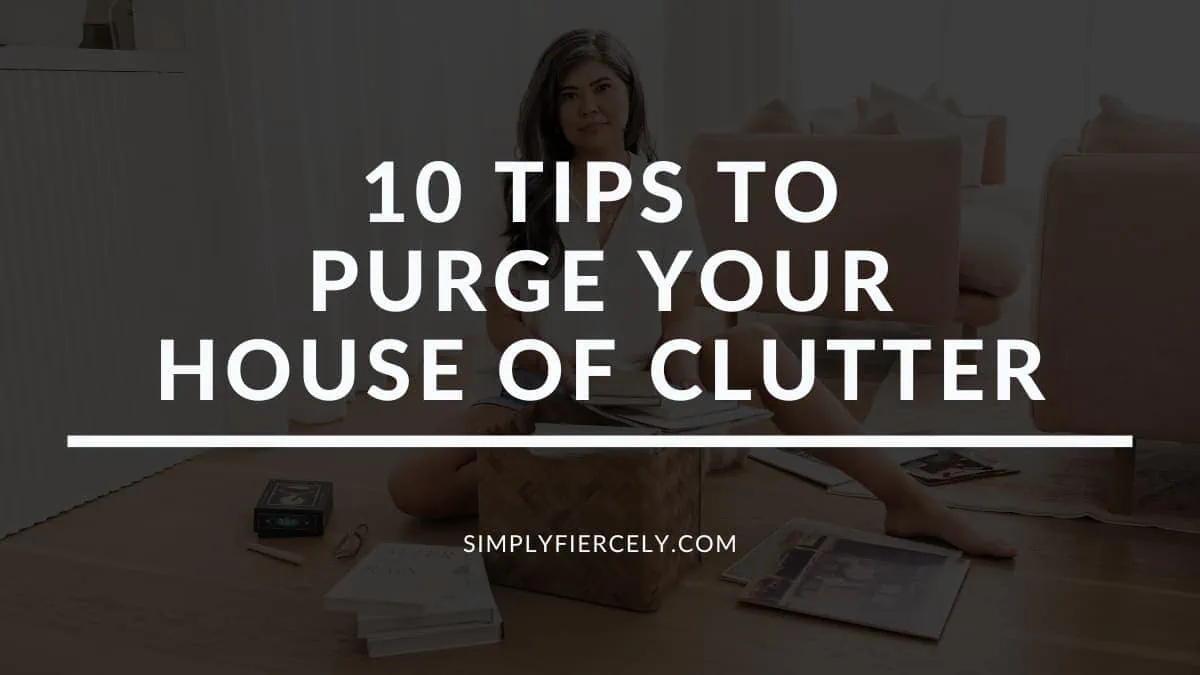If you want to purge your house of clutter but don’t know where to start, these tips are for you!
Your home should be a place to relax and recharge, but that’s hard to do when you’re drowning in clutter. Instead of feeling at ease when you open your front door, you’re confronted by unfinished projects and endless piles.
Ugh. As a former shopaholic, I’ve been there and I know it’s not fun. Too much stuff can be suffocating–but here’s the good news.
I’ve decluttered over 80% of my belongings, and in this blog post, I’m sharing practical tips that will help you purge your house of clutter. (And no, this doesn’t mean you have to commit to an ultra-minimalist lifestyle or anything like that!) But there are things that will help you live with less stuff and less stress, so let’s get started!
This post contains affiliate links, which means I recommend products and make a small commission on purchases at no additional cost to you. Click here for the full disclosure statement.
How to Purge Your House (10 Helpful Tips)
#1 Write a list of reasons why you’re decluttering
I know many of you will resist this step because it doesn’t feel productive (and we’re programmed to be busy all the time, aren’t we?). But I promise that taking 10 minutes to write a quick list of reasons why you’re decluttering is an essential first step.
Why? Because what we think about is what our brains focus on.
Consider a mosquito bite. The more you think about the itch, the more it annoys you—but when you’re distracted by something else, the irritation fades away.
The same thing happens when we’re decluttering. Our minds have a habit of looking for problems (“But what if I need this someday?”), and next thing you know, it’s all you can think about. But if you distract yourself with a list, it becomes much easier to let go.
Check out this post about the benefits of decluttering if you need inspiration!
#2 Determine the “first obvious action”
This is an idea I borrowed from Greg McKeown’s book Effortless affiliate link. In it, he writes:
”We often get overwhelmed because we misjudge what the first step actually is: what we think is the first step is actually several steps. But once we break it down into concrete, physical actions, that first obvious step begins to feel effortless.“
You feel overwhelmed when you’re decluttering because you think about the entire process all at once. It’s too much, and your brain gives up before you even begin.
Instead, try breaking things down in practical step-by-step actions—and a great way to do this is by following your excuses. Ask yourself why you can’t declutter right now and see what comes up. Here’s an example:
- ?Why can’t you declutter right now? I don’t have time.
- When do you have time? I could get started tomorrow but I don’t know where to begin.
- What is one project you’d like to tackle first? My closet, but I want to sell some of my clothes and I don’t know where to sell them.
Now, we’ve identified the first obvious action: researching the best places to sell your secondhand clothes.
Of course, it won’t be this complicated for everyone. Sometimes, all you need to do is pick a place and get started! But if you’re procrastinating or feeling overwhelmed, this simple exercise can help you overcome that block.
#3 Tackle low-hanging fruit first
A lot of decluttering advice recommends completely clearing a space before you start, but that’s not always necessary. Plus, nothing’s worse than getting halfway through a project, running out of steam, and then realising you’re stuck with a big mess to deal with.
Instead, I think the best way to begin is almost always with the easy stuff!
Do a sweep of your space and clear any obviously unwanted items. Don’t overthink it—just purge, purge, purge! Tackle things like old magazines, expired cosmetics, torn clothing, etc. and leave sentimental items or other confusing items aside for now.
?#4 Name your trade-offs
Once you’ve made progress with your easy items, it’s time to tackle what I call “stubborn clutter”. These are items where you feel confusion or resistance to letting go, and one of the easiest ways to create clarity is by naming your trade-offs.
For example, let’s say you want to keep ten pairs of jeans when deep down, you know you only wear the same three pairs on repeat. (No judgement—we’ve all been there!) But here’s the hard truth: keeping those extra pairs has a cost.
Maybe it‘s a cost to your well-being (do you feel stressed or overwhelmed when you open your closet?). Or perhaps those extra pairs are costing you time (do you ever struggle to find what you’re looking for in the mornings?).
For me, the cost of keeping too many clothes is how much energy I used to spend trying to make things work. When I was deep in my shopping addiction, I was always trying on clothes I knew didn’t fit or looking for new items that would “miraculously“ transform my wardrobe.
(Spoiler alert: that never happened. I eventually learned that if you’re not happy with yourself, then nothing you buy will make you feel different.)
Anyway, I know it can be hard to recognise in the moment—what’s the harm in keeping one more pair of jeans—but now that I’m on the other side, I can’t begin to explain how much better it is. My minimalist wardrobe has helped me reclaim so much of my life that I didn’t realise I was trading away.
#5 Challenge “just in case” items
Another type of stubborn clutter are the things we‘re tempted to keep “just in case” we’ll use or need them someday. But here’s a hack that will have you tipping a lot of stuff in your donation bags!
Every time you’re tempted to keep something “just in case,” ask yourself this:
What would I do if I needed this item and didn’t have it?
Often, the answer is “make do with something else” or “experience a minor discomfort”. I used to experience this a lot with fashion—I was always worried about getting rid of something and then needing it to complete an outfit.
But I’ve since realised I can often make do with something that isn’t perfect but good enough. And sure, sometimes there’s a twinge of annoyance, but it’s nothing compared to the constant strain of living in a cluttered home.
#6 Decide how much is enough
This is a decluttering tip for everyone, but it’s especially helpful for those living in small spaces. (And for reference, I live in 660 square feet with my husband and two kids, so I understand small space living!) Even a tiny bit of extra stuff adds up, so here’s what I do to avoid it.
I decide how much is enough in as many areas as possible.
Sometimes, this looks like deciding on a quantity (for example, keeping ‘x’ number of certain household items). But more often, I think about space.
Try designating a specific area for your items and then honour that physical boundary. For example, I have one shelf for towels, and that’s it. I purged everything that wouldn’t fit on that shelf, and now I don’t buy more because I know I have enough.
#7 Work in short bursts
I know that purging your entire house can feel overwhelming, and that’s why so many people put it off. It’s a task we’ll get to “someday” when we have more time, right?
But that magical someday rarely comes, which is why I recommend working in slow bursts. Specifically, you can try something I use all the time when I’m writing: the Pomodoro Method.
Simply set a timer for a short period (say 25 minutes) and then do as much as you can during that period. When the timer goes off, take a short break and repeat the process (but don’t overdo it — decluttering burnout is real!)
#8 Decide what you won’t keep
?One of the things that makes decluttering so hard is decision fatigue?, a theory that states our brains can only make so many decisions before getting tired. Most of us have experienced this firsthand: at the end of a long workday or a busy weekend, making the most straightforward decision (like what to have for dinner) can feel impossible!
The same thing happens when trying to purge your home. You’ve got hundreds if not thousands of items to tackle, and if you want to maintain momentum, you’ve got to conserve energy—and one way you can do this is by keeping a running list of what you won’t keep.
What goes on this will be different for everyone. For me, it included things like dry-clean-only clothes, cookbooks, and old journals. For you, it might include half-burnt candles or old clothes with holes in them. Whatever you decide, keep a running list of items so you have one less thing to think about.
Related Post: 5 Helpful Decluttering Checklists For Your Home
#9 Designate a spot for everything
This is a popular decluttering tip, for good reason! Everything you own should have a designated spot in your home, and if you can’t think of one, it’s often because your item does’t have a clear purpose.
… and if doesn’t serve a clear purpose, reconsider whether you need to keep this item!
Pro Tip: You can also use this tip to prevent clutter. Before you buy anything, figure out exactly where you’re going to put it or leave it in the shops.
#10 Look for ways to add fun to your decluttering
I recently read Feel Good Productivity by Ali Abdal affiliate link, and one key takeaway is that joy is the best motivator.
Sure, discipline and habits also play a role, but if you’ve ever tried to force yourself into a strict decluttering schedule, then you‘ll know what I mean. There are limits to what we can push ourselves to do, and sometimes, it’s better to use a carrot than a stick.
So how can we do this? Well, one of Abdal’s suggestions is to bring more play into our days, and you can do this too by gamifying your decluttering. Experiment with decluttering challenges, set silly targets (today, I’m going to declutter five blue items), make a new playlist, or play decluttering bingo—the possibilities are endless!
?And don’t forget—the best part of purging your house is letting go of what weighs you down. What could be more joyful than that?
The Simply + Fiercely Show is a podcast for women who want to clear their clutter and create space for freedom and joy. If your life keeps getting bigger—but not better—then it’s time to declutter from the inside out. LISTEN NOW
More Tips That Will Help You Purge Clutter
If you enjoyed this blog post, you might also like:

